73196 Assignment 2: Attribution and Perception of Behavior Report
VerifiedAdded on 2023/06/04
|14
|2918
|402
Report
AI Summary
This report delves into the realm of social and individual psychology, specifically focusing on attributions and the perception of behavior. It begins by defining key terms like internal and external attributions, and social norms, providing a foundation for understanding how individuals interpret th...
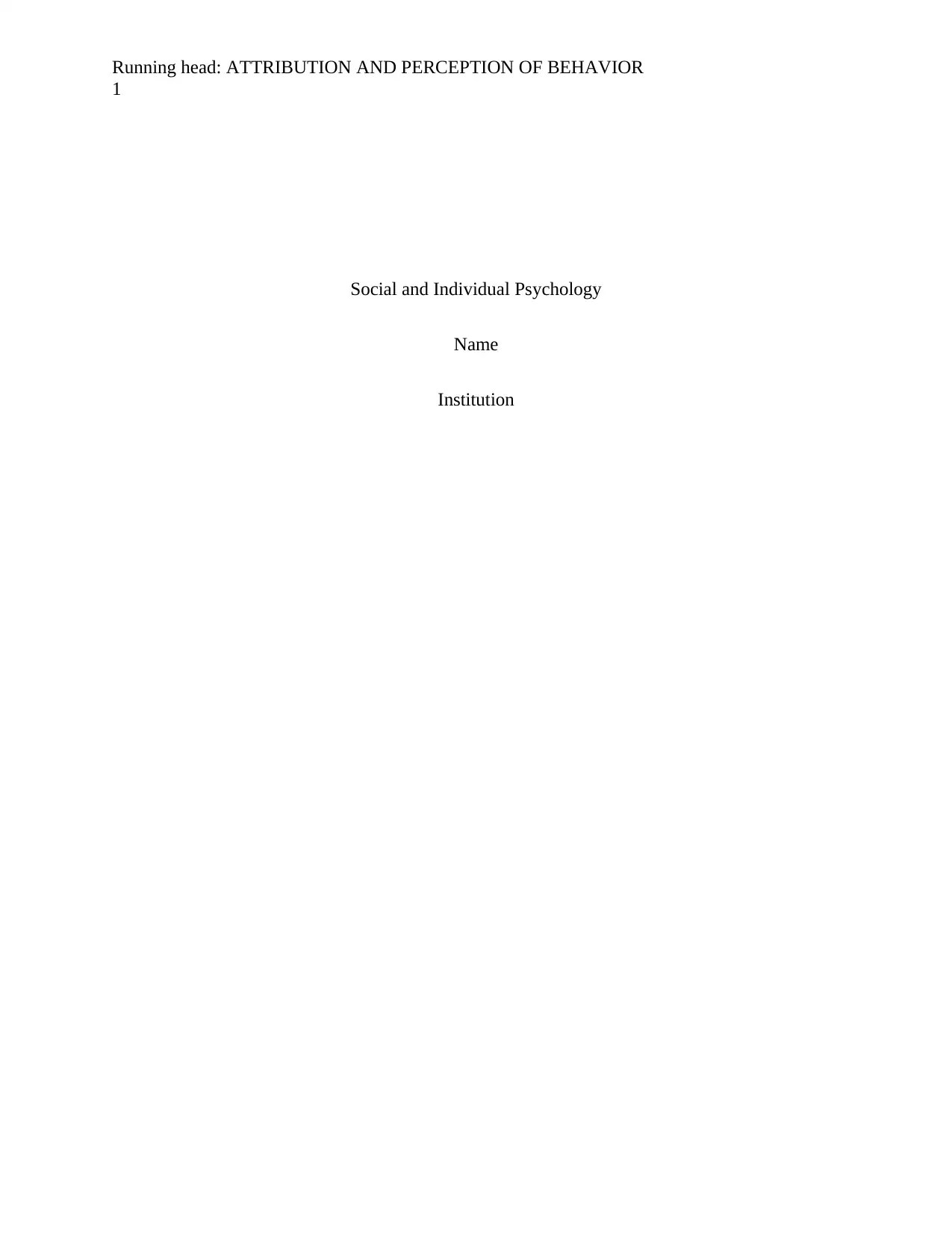
Running head: ATTRIBUTION AND PERCEPTION OF BEHAVIOR
1
Social and Individual Psychology
Name
Institution
1
Social and Individual Psychology
Name
Institution
Paraphrase This Document
Need a fresh take? Get an instant paraphrase of this document with our AI Paraphraser
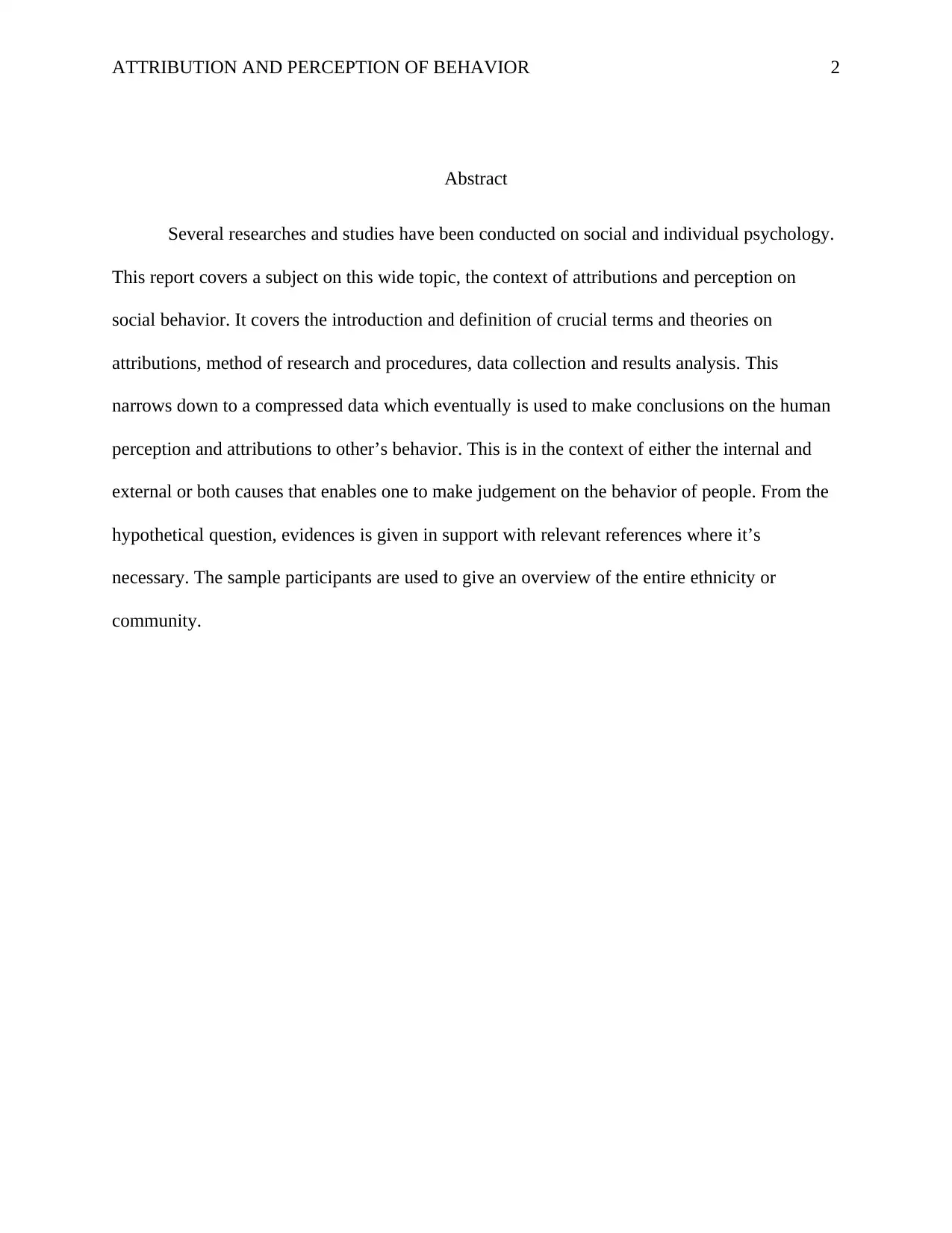
ATTRIBUTION AND PERCEPTION OF BEHAVIOR 2
Abstract
Several researches and studies have been conducted on social and individual psychology.
This report covers a subject on this wide topic, the context of attributions and perception on
social behavior. It covers the introduction and definition of crucial terms and theories on
attributions, method of research and procedures, data collection and results analysis. This
narrows down to a compressed data which eventually is used to make conclusions on the human
perception and attributions to other’s behavior. This is in the context of either the internal and
external or both causes that enables one to make judgement on the behavior of people. From the
hypothetical question, evidences is given in support with relevant references where it’s
necessary. The sample participants are used to give an overview of the entire ethnicity or
community.
Abstract
Several researches and studies have been conducted on social and individual psychology.
This report covers a subject on this wide topic, the context of attributions and perception on
social behavior. It covers the introduction and definition of crucial terms and theories on
attributions, method of research and procedures, data collection and results analysis. This
narrows down to a compressed data which eventually is used to make conclusions on the human
perception and attributions to other’s behavior. This is in the context of either the internal and
external or both causes that enables one to make judgement on the behavior of people. From the
hypothetical question, evidences is given in support with relevant references where it’s
necessary. The sample participants are used to give an overview of the entire ethnicity or
community.
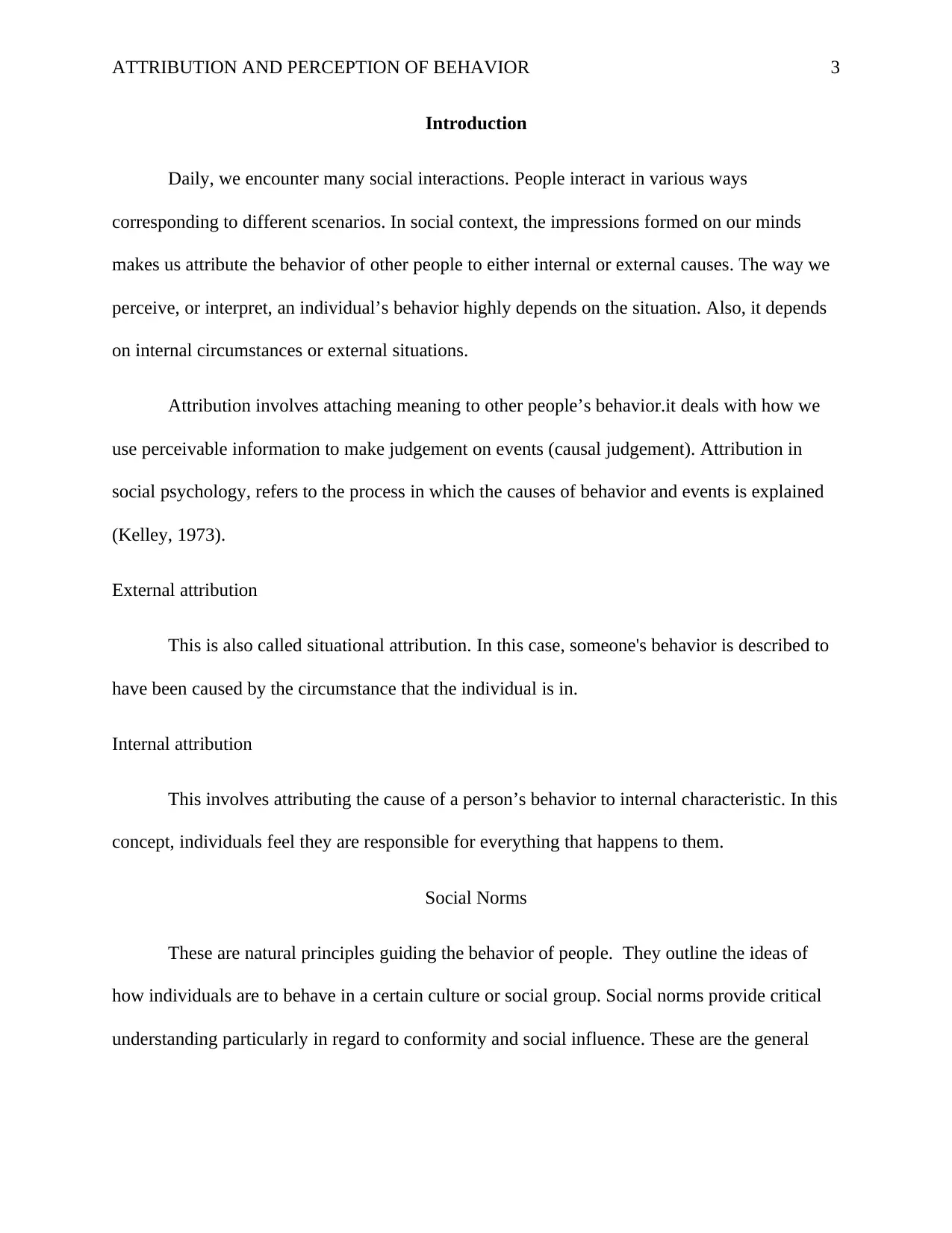
ATTRIBUTION AND PERCEPTION OF BEHAVIOR 3
Introduction
Daily, we encounter many social interactions. People interact in various ways
corresponding to different scenarios. In social context, the impressions formed on our minds
makes us attribute the behavior of other people to either internal or external causes. The way we
perceive, or interpret, an individual’s behavior highly depends on the situation. Also, it depends
on internal circumstances or external situations.
Attribution involves attaching meaning to other people’s behavior.it deals with how we
use perceivable information to make judgement on events (causal judgement). Attribution in
social psychology, refers to the process in which the causes of behavior and events is explained
(Kelley, 1973).
External attribution
This is also called situational attribution. In this case, someone's behavior is described to
have been caused by the circumstance that the individual is in.
Internal attribution
This involves attributing the cause of a person’s behavior to internal characteristic. In this
concept, individuals feel they are responsible for everything that happens to them.
Social Norms
These are natural principles guiding the behavior of people. They outline the ideas of
how individuals are to behave in a certain culture or social group. Social norms provide critical
understanding particularly in regard to conformity and social influence. These are the general
Introduction
Daily, we encounter many social interactions. People interact in various ways
corresponding to different scenarios. In social context, the impressions formed on our minds
makes us attribute the behavior of other people to either internal or external causes. The way we
perceive, or interpret, an individual’s behavior highly depends on the situation. Also, it depends
on internal circumstances or external situations.
Attribution involves attaching meaning to other people’s behavior.it deals with how we
use perceivable information to make judgement on events (causal judgement). Attribution in
social psychology, refers to the process in which the causes of behavior and events is explained
(Kelley, 1973).
External attribution
This is also called situational attribution. In this case, someone's behavior is described to
have been caused by the circumstance that the individual is in.
Internal attribution
This involves attributing the cause of a person’s behavior to internal characteristic. In this
concept, individuals feel they are responsible for everything that happens to them.
Social Norms
These are natural principles guiding the behavior of people. They outline the ideas of
how individuals are to behave in a certain culture or social group. Social norms provide critical
understanding particularly in regard to conformity and social influence. These are the general
⊘ This is a preview!⊘
Do you want full access?
Subscribe today to unlock all pages.

Trusted by 1+ million students worldwide
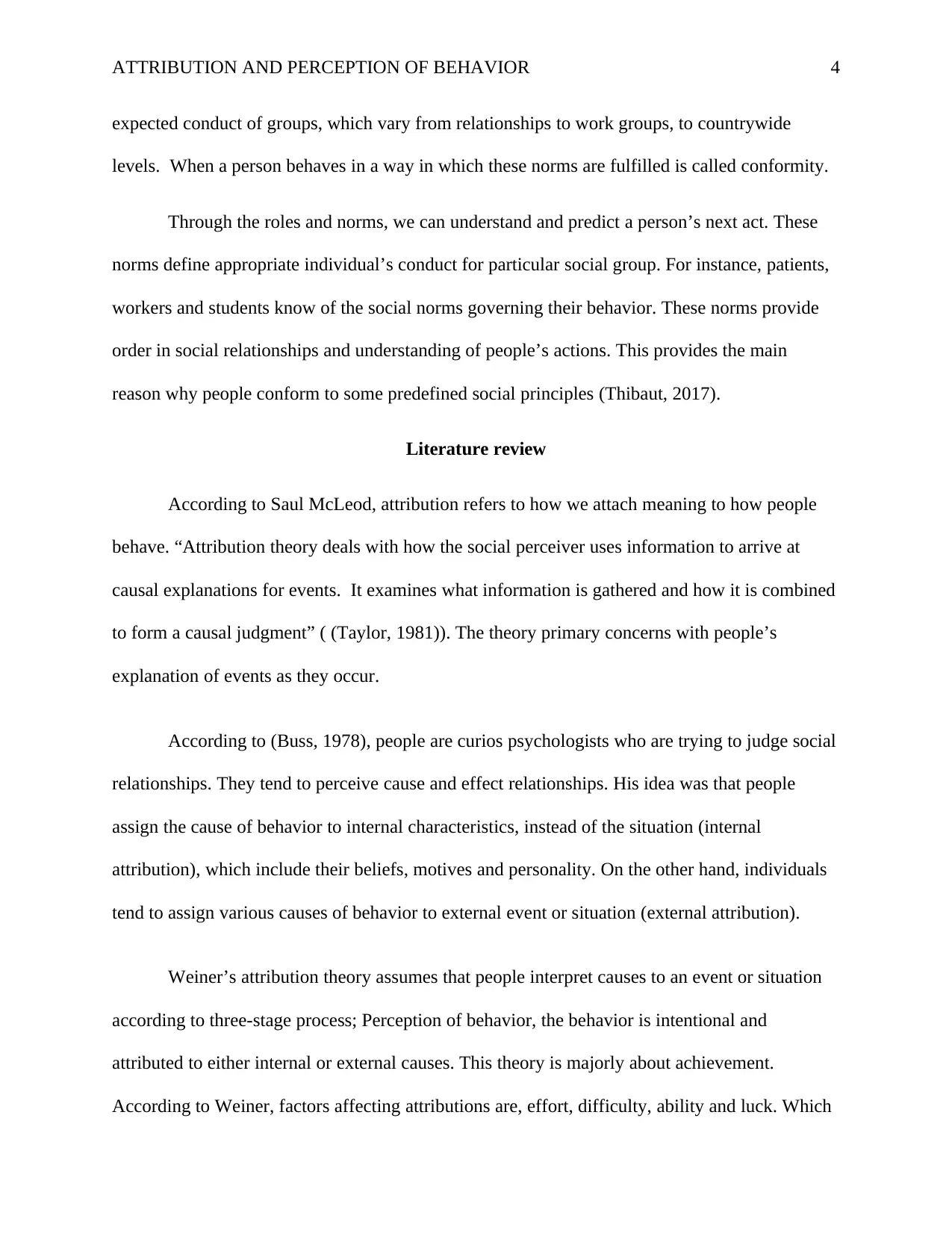
ATTRIBUTION AND PERCEPTION OF BEHAVIOR 4
expected conduct of groups, which vary from relationships to work groups, to countrywide
levels. When a person behaves in a way in which these norms are fulfilled is called conformity.
Through the roles and norms, we can understand and predict a person’s next act. These
norms define appropriate individual’s conduct for particular social group. For instance, patients,
workers and students know of the social norms governing their behavior. These norms provide
order in social relationships and understanding of people’s actions. This provides the main
reason why people conform to some predefined social principles (Thibaut, 2017).
Literature review
According to Saul McLeod, attribution refers to how we attach meaning to how people
behave. “Attribution theory deals with how the social perceiver uses information to arrive at
causal explanations for events. It examines what information is gathered and how it is combined
to form a causal judgment” ( (Taylor, 1981)). The theory primary concerns with people’s
explanation of events as they occur.
According to (Buss, 1978), people are curios psychologists who are trying to judge social
relationships. They tend to perceive cause and effect relationships. His idea was that people
assign the cause of behavior to internal characteristics, instead of the situation (internal
attribution), which include their beliefs, motives and personality. On the other hand, individuals
tend to assign various causes of behavior to external event or situation (external attribution).
Weiner’s attribution theory assumes that people interpret causes to an event or situation
according to three-stage process; Perception of behavior, the behavior is intentional and
attributed to either internal or external causes. This theory is majorly about achievement.
According to Weiner, factors affecting attributions are, effort, difficulty, ability and luck. Which
expected conduct of groups, which vary from relationships to work groups, to countrywide
levels. When a person behaves in a way in which these norms are fulfilled is called conformity.
Through the roles and norms, we can understand and predict a person’s next act. These
norms define appropriate individual’s conduct for particular social group. For instance, patients,
workers and students know of the social norms governing their behavior. These norms provide
order in social relationships and understanding of people’s actions. This provides the main
reason why people conform to some predefined social principles (Thibaut, 2017).
Literature review
According to Saul McLeod, attribution refers to how we attach meaning to how people
behave. “Attribution theory deals with how the social perceiver uses information to arrive at
causal explanations for events. It examines what information is gathered and how it is combined
to form a causal judgment” ( (Taylor, 1981)). The theory primary concerns with people’s
explanation of events as they occur.
According to (Buss, 1978), people are curios psychologists who are trying to judge social
relationships. They tend to perceive cause and effect relationships. His idea was that people
assign the cause of behavior to internal characteristics, instead of the situation (internal
attribution), which include their beliefs, motives and personality. On the other hand, individuals
tend to assign various causes of behavior to external event or situation (external attribution).
Weiner’s attribution theory assumes that people interpret causes to an event or situation
according to three-stage process; Perception of behavior, the behavior is intentional and
attributed to either internal or external causes. This theory is majorly about achievement.
According to Weiner, factors affecting attributions are, effort, difficulty, ability and luck. Which
Paraphrase This Document
Need a fresh take? Get an instant paraphrase of this document with our AI Paraphraser
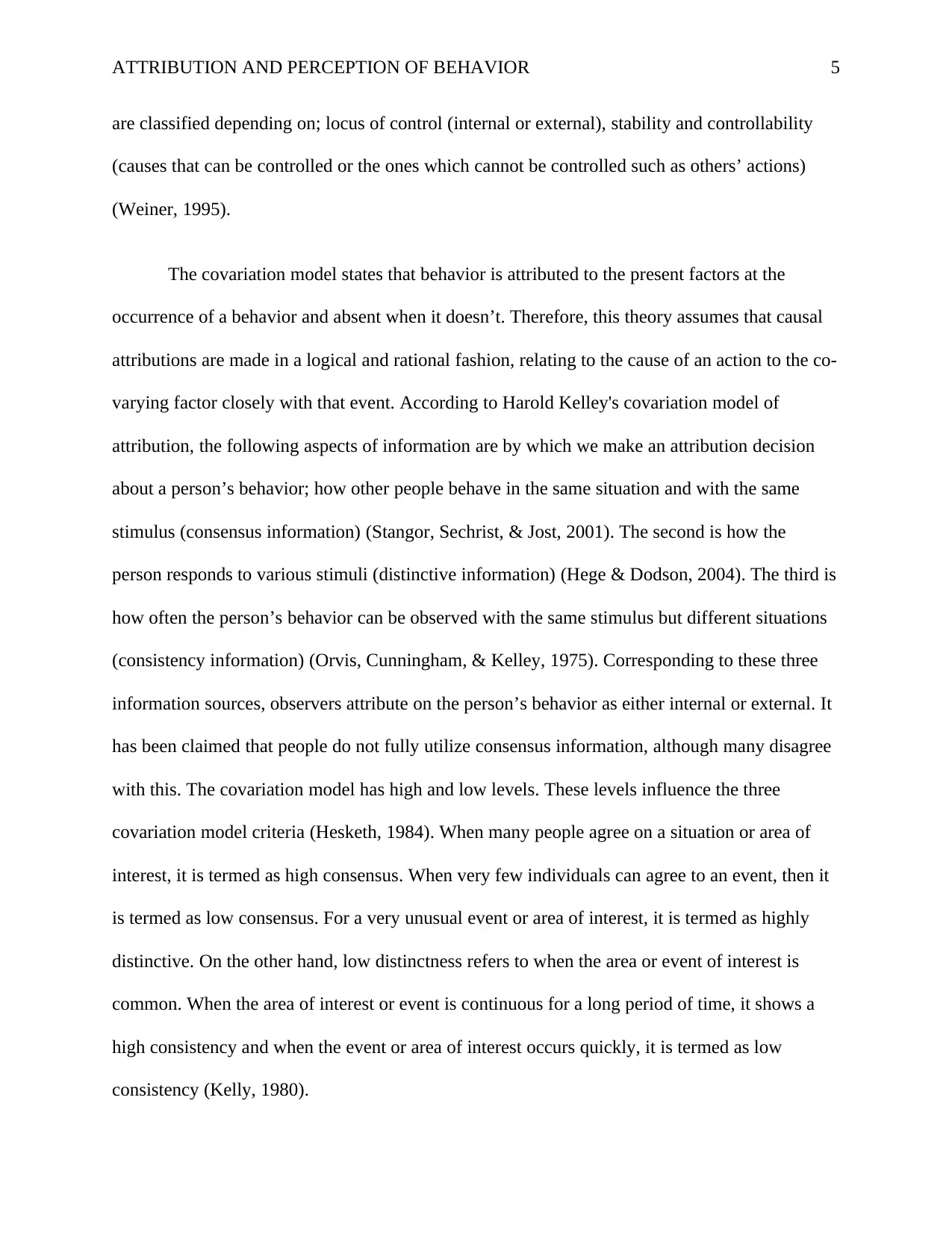
ATTRIBUTION AND PERCEPTION OF BEHAVIOR 5
are classified depending on; locus of control (internal or external), stability and controllability
(causes that can be controlled or the ones which cannot be controlled such as others’ actions)
(Weiner, 1995).
The covariation model states that behavior is attributed to the present factors at the
occurrence of a behavior and absent when it doesn’t. Therefore, this theory assumes that causal
attributions are made in a logical and rational fashion, relating to the cause of an action to the co-
varying factor closely with that event. According to Harold Kelley's covariation model of
attribution, the following aspects of information are by which we make an attribution decision
about a person’s behavior; how other people behave in the same situation and with the same
stimulus (consensus information) (Stangor, Sechrist, & Jost, 2001). The second is how the
person responds to various stimuli (distinctive information) (Hege & Dodson, 2004). The third is
how often the person’s behavior can be observed with the same stimulus but different situations
(consistency information) (Orvis, Cunningham, & Kelley, 1975). Corresponding to these three
information sources, observers attribute on the person’s behavior as either internal or external. It
has been claimed that people do not fully utilize consensus information, although many disagree
with this. The covariation model has high and low levels. These levels influence the three
covariation model criteria (Hesketh, 1984). When many people agree on a situation or area of
interest, it is termed as high consensus. When very few individuals can agree to an event, then it
is termed as low consensus. For a very unusual event or area of interest, it is termed as highly
distinctive. On the other hand, low distinctness refers to when the area or event of interest is
common. When the area of interest or event is continuous for a long period of time, it shows a
high consistency and when the event or area of interest occurs quickly, it is termed as low
consistency (Kelly, 1980).
are classified depending on; locus of control (internal or external), stability and controllability
(causes that can be controlled or the ones which cannot be controlled such as others’ actions)
(Weiner, 1995).
The covariation model states that behavior is attributed to the present factors at the
occurrence of a behavior and absent when it doesn’t. Therefore, this theory assumes that causal
attributions are made in a logical and rational fashion, relating to the cause of an action to the co-
varying factor closely with that event. According to Harold Kelley's covariation model of
attribution, the following aspects of information are by which we make an attribution decision
about a person’s behavior; how other people behave in the same situation and with the same
stimulus (consensus information) (Stangor, Sechrist, & Jost, 2001). The second is how the
person responds to various stimuli (distinctive information) (Hege & Dodson, 2004). The third is
how often the person’s behavior can be observed with the same stimulus but different situations
(consistency information) (Orvis, Cunningham, & Kelley, 1975). Corresponding to these three
information sources, observers attribute on the person’s behavior as either internal or external. It
has been claimed that people do not fully utilize consensus information, although many disagree
with this. The covariation model has high and low levels. These levels influence the three
covariation model criteria (Hesketh, 1984). When many people agree on a situation or area of
interest, it is termed as high consensus. When very few individuals can agree to an event, then it
is termed as low consensus. For a very unusual event or area of interest, it is termed as highly
distinctive. On the other hand, low distinctness refers to when the area or event of interest is
common. When the area of interest or event is continuous for a long period of time, it shows a
high consistency and when the event or area of interest occurs quickly, it is termed as low
consistency (Kelly, 1980).
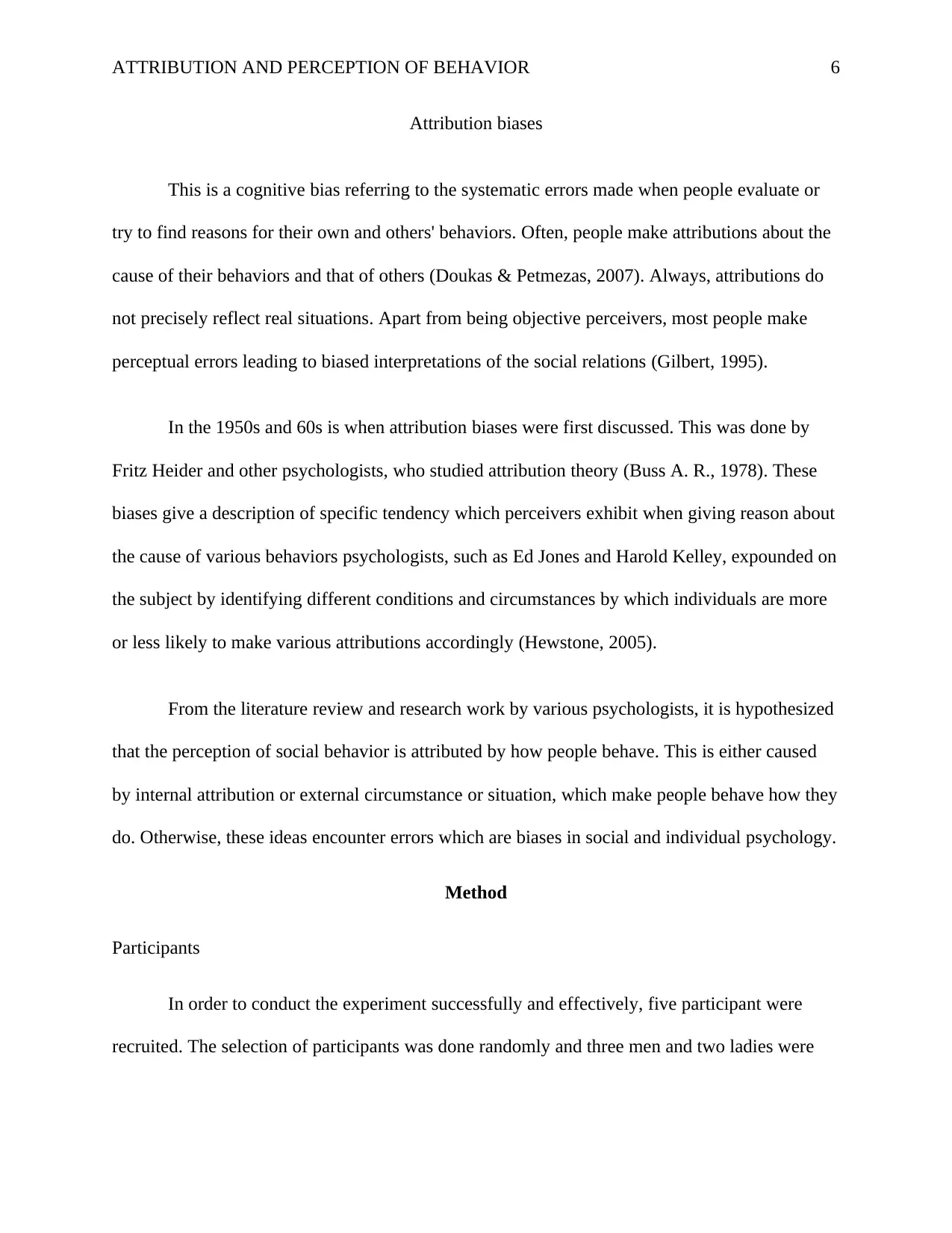
ATTRIBUTION AND PERCEPTION OF BEHAVIOR 6
Attribution biases
This is a cognitive bias referring to the systematic errors made when people evaluate or
try to find reasons for their own and others' behaviors. Often, people make attributions about the
cause of their behaviors and that of others (Doukas & Petmezas, 2007). Always, attributions do
not precisely reflect real situations. Apart from being objective perceivers, most people make
perceptual errors leading to biased interpretations of the social relations (Gilbert, 1995).
In the 1950s and 60s is when attribution biases were first discussed. This was done by
Fritz Heider and other psychologists, who studied attribution theory (Buss A. R., 1978). These
biases give a description of specific tendency which perceivers exhibit when giving reason about
the cause of various behaviors psychologists, such as Ed Jones and Harold Kelley, expounded on
the subject by identifying different conditions and circumstances by which individuals are more
or less likely to make various attributions accordingly (Hewstone, 2005).
From the literature review and research work by various psychologists, it is hypothesized
that the perception of social behavior is attributed by how people behave. This is either caused
by internal attribution or external circumstance or situation, which make people behave how they
do. Otherwise, these ideas encounter errors which are biases in social and individual psychology.
Method
Participants
In order to conduct the experiment successfully and effectively, five participant were
recruited. The selection of participants was done randomly and three men and two ladies were
Attribution biases
This is a cognitive bias referring to the systematic errors made when people evaluate or
try to find reasons for their own and others' behaviors. Often, people make attributions about the
cause of their behaviors and that of others (Doukas & Petmezas, 2007). Always, attributions do
not precisely reflect real situations. Apart from being objective perceivers, most people make
perceptual errors leading to biased interpretations of the social relations (Gilbert, 1995).
In the 1950s and 60s is when attribution biases were first discussed. This was done by
Fritz Heider and other psychologists, who studied attribution theory (Buss A. R., 1978). These
biases give a description of specific tendency which perceivers exhibit when giving reason about
the cause of various behaviors psychologists, such as Ed Jones and Harold Kelley, expounded on
the subject by identifying different conditions and circumstances by which individuals are more
or less likely to make various attributions accordingly (Hewstone, 2005).
From the literature review and research work by various psychologists, it is hypothesized
that the perception of social behavior is attributed by how people behave. This is either caused
by internal attribution or external circumstance or situation, which make people behave how they
do. Otherwise, these ideas encounter errors which are biases in social and individual psychology.
Method
Participants
In order to conduct the experiment successfully and effectively, five participant were
recruited. The selection of participants was done randomly and three men and two ladies were
⊘ This is a preview!⊘
Do you want full access?
Subscribe today to unlock all pages.

Trusted by 1+ million students worldwide
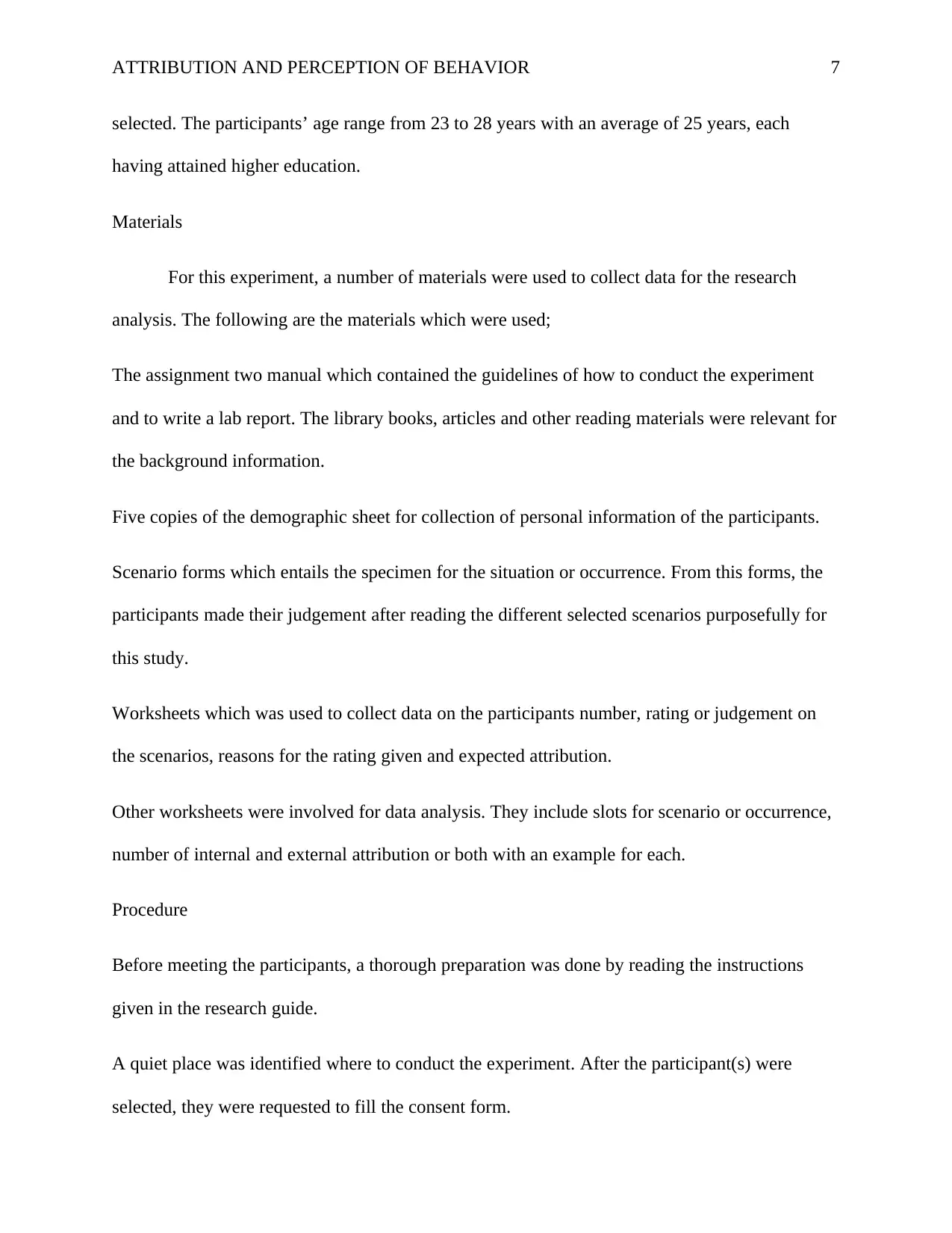
ATTRIBUTION AND PERCEPTION OF BEHAVIOR 7
selected. The participants’ age range from 23 to 28 years with an average of 25 years, each
having attained higher education.
Materials
For this experiment, a number of materials were used to collect data for the research
analysis. The following are the materials which were used;
The assignment two manual which contained the guidelines of how to conduct the experiment
and to write a lab report. The library books, articles and other reading materials were relevant for
the background information.
Five copies of the demographic sheet for collection of personal information of the participants.
Scenario forms which entails the specimen for the situation or occurrence. From this forms, the
participants made their judgement after reading the different selected scenarios purposefully for
this study.
Worksheets which was used to collect data on the participants number, rating or judgement on
the scenarios, reasons for the rating given and expected attribution.
Other worksheets were involved for data analysis. They include slots for scenario or occurrence,
number of internal and external attribution or both with an example for each.
Procedure
Before meeting the participants, a thorough preparation was done by reading the instructions
given in the research guide.
A quiet place was identified where to conduct the experiment. After the participant(s) were
selected, they were requested to fill the consent form.
selected. The participants’ age range from 23 to 28 years with an average of 25 years, each
having attained higher education.
Materials
For this experiment, a number of materials were used to collect data for the research
analysis. The following are the materials which were used;
The assignment two manual which contained the guidelines of how to conduct the experiment
and to write a lab report. The library books, articles and other reading materials were relevant for
the background information.
Five copies of the demographic sheet for collection of personal information of the participants.
Scenario forms which entails the specimen for the situation or occurrence. From this forms, the
participants made their judgement after reading the different selected scenarios purposefully for
this study.
Worksheets which was used to collect data on the participants number, rating or judgement on
the scenarios, reasons for the rating given and expected attribution.
Other worksheets were involved for data analysis. They include slots for scenario or occurrence,
number of internal and external attribution or both with an example for each.
Procedure
Before meeting the participants, a thorough preparation was done by reading the instructions
given in the research guide.
A quiet place was identified where to conduct the experiment. After the participant(s) were
selected, they were requested to fill the consent form.
Paraphrase This Document
Need a fresh take? Get an instant paraphrase of this document with our AI Paraphraser
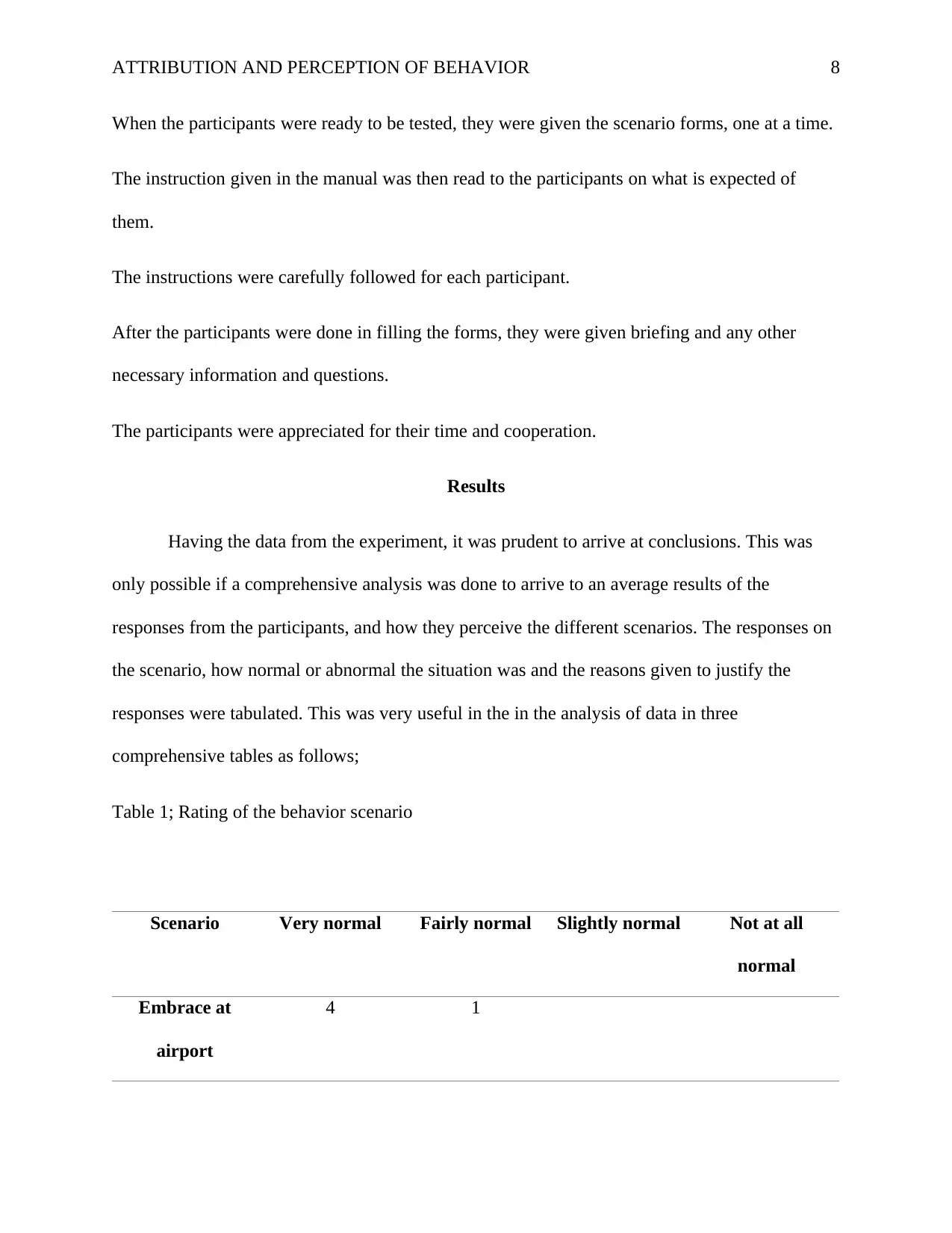
ATTRIBUTION AND PERCEPTION OF BEHAVIOR 8
When the participants were ready to be tested, they were given the scenario forms, one at a time.
The instruction given in the manual was then read to the participants on what is expected of
them.
The instructions were carefully followed for each participant.
After the participants were done in filling the forms, they were given briefing and any other
necessary information and questions.
The participants were appreciated for their time and cooperation.
Results
Having the data from the experiment, it was prudent to arrive at conclusions. This was
only possible if a comprehensive analysis was done to arrive to an average results of the
responses from the participants, and how they perceive the different scenarios. The responses on
the scenario, how normal or abnormal the situation was and the reasons given to justify the
responses were tabulated. This was very useful in the in the analysis of data in three
comprehensive tables as follows;
Table 1; Rating of the behavior scenario
Scenario Very normal Fairly normal Slightly normal Not at all
normal
Embrace at
airport
4 1
When the participants were ready to be tested, they were given the scenario forms, one at a time.
The instruction given in the manual was then read to the participants on what is expected of
them.
The instructions were carefully followed for each participant.
After the participants were done in filling the forms, they were given briefing and any other
necessary information and questions.
The participants were appreciated for their time and cooperation.
Results
Having the data from the experiment, it was prudent to arrive at conclusions. This was
only possible if a comprehensive analysis was done to arrive to an average results of the
responses from the participants, and how they perceive the different scenarios. The responses on
the scenario, how normal or abnormal the situation was and the reasons given to justify the
responses were tabulated. This was very useful in the in the analysis of data in three
comprehensive tables as follows;
Table 1; Rating of the behavior scenario
Scenario Very normal Fairly normal Slightly normal Not at all
normal
Embrace at
airport
4 1
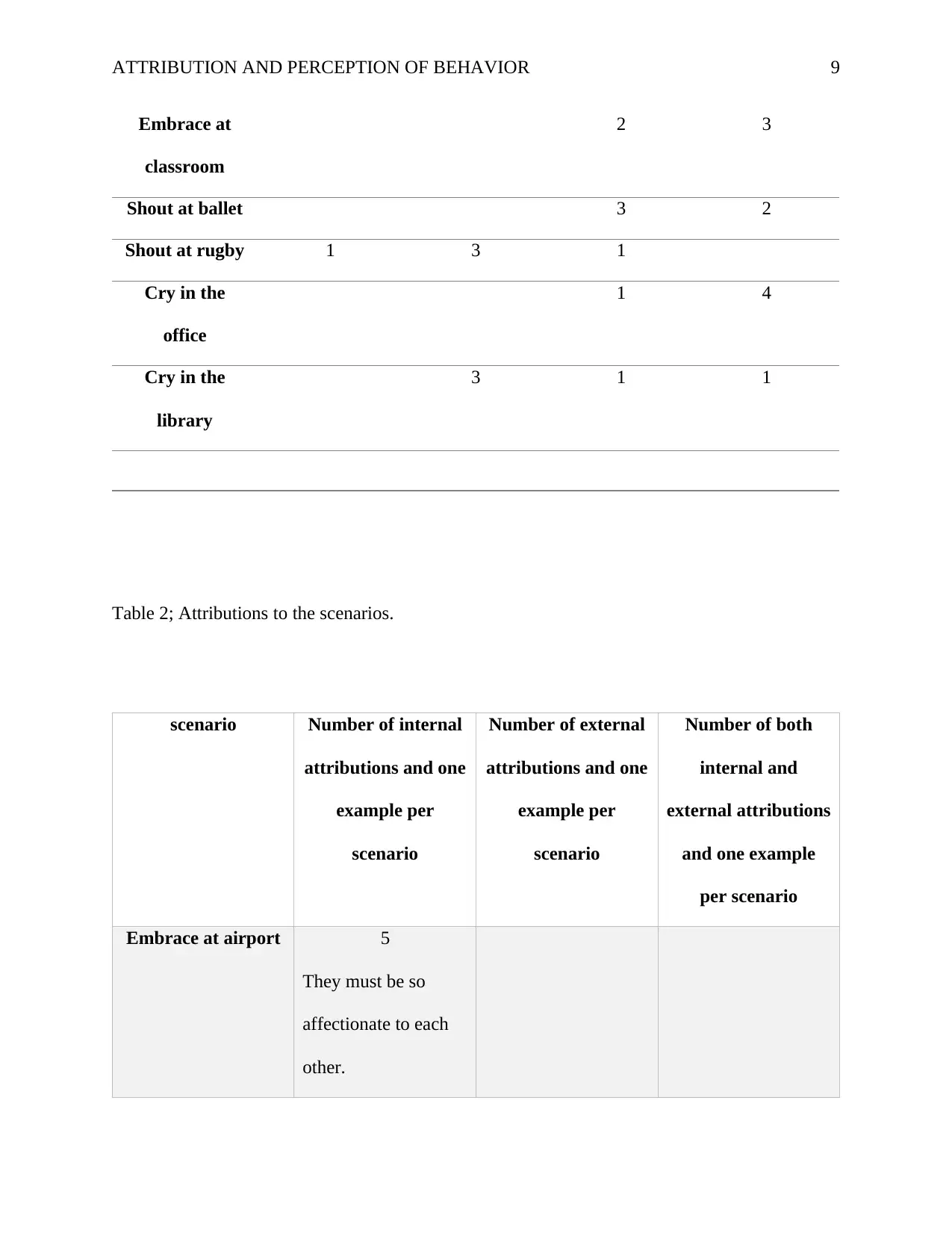
ATTRIBUTION AND PERCEPTION OF BEHAVIOR 9
Embrace at
classroom
2 3
Shout at ballet 3 2
Shout at rugby 1 3 1
Cry in the
office
1 4
Cry in the
library
3 1 1
Table 2; Attributions to the scenarios.
scenario Number of internal
attributions and one
example per
scenario
Number of external
attributions and one
example per
scenario
Number of both
internal and
external attributions
and one example
per scenario
Embrace at airport 5
They must be so
affectionate to each
other.
Embrace at
classroom
2 3
Shout at ballet 3 2
Shout at rugby 1 3 1
Cry in the
office
1 4
Cry in the
library
3 1 1
Table 2; Attributions to the scenarios.
scenario Number of internal
attributions and one
example per
scenario
Number of external
attributions and one
example per
scenario
Number of both
internal and
external attributions
and one example
per scenario
Embrace at airport 5
They must be so
affectionate to each
other.
⊘ This is a preview!⊘
Do you want full access?
Subscribe today to unlock all pages.

Trusted by 1+ million students worldwide
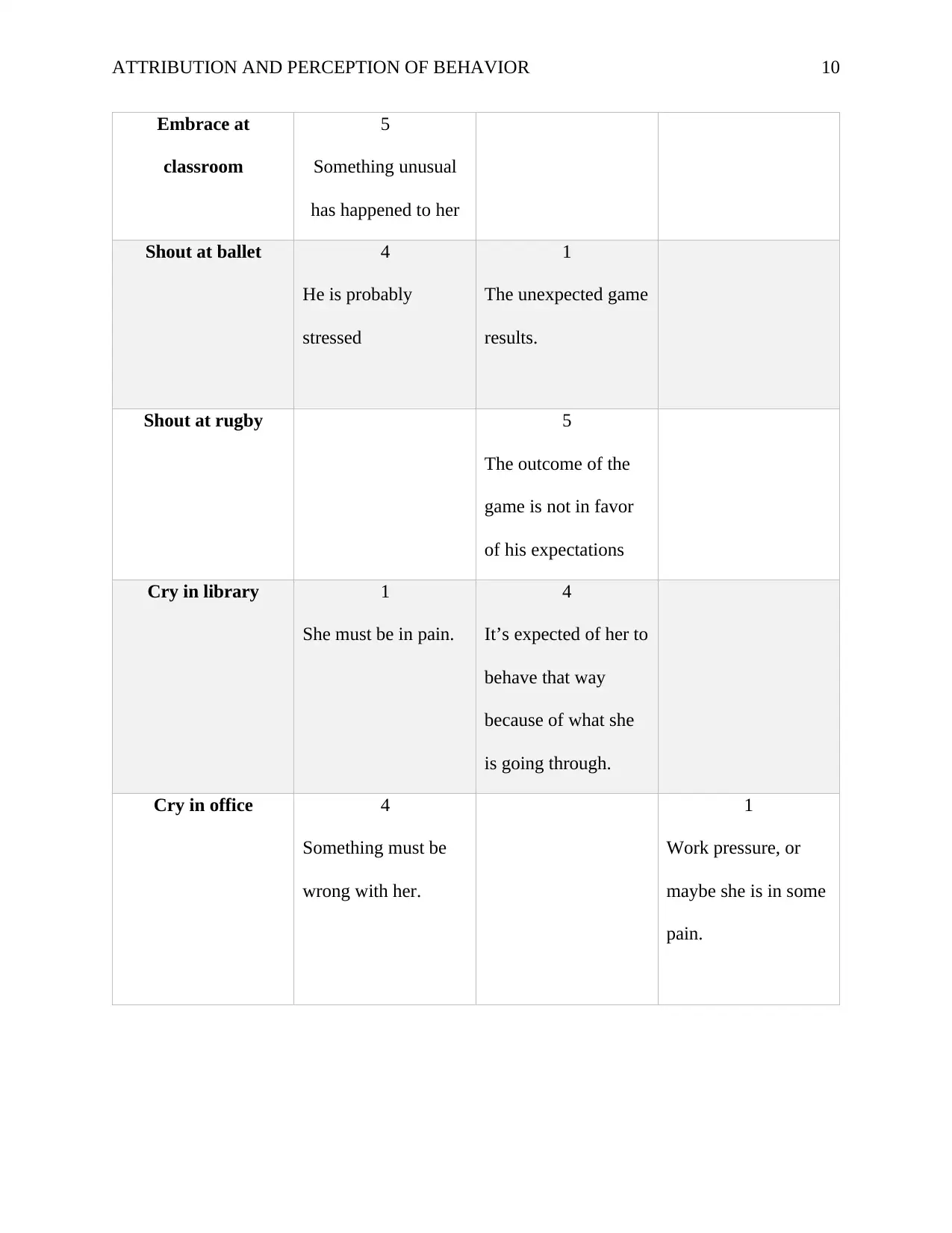
ATTRIBUTION AND PERCEPTION OF BEHAVIOR 10
Embrace at
classroom
5
Something unusual
has happened to her
Shout at ballet 4
He is probably
stressed
1
The unexpected game
results.
Shout at rugby 5
The outcome of the
game is not in favor
of his expectations
Cry in library 1
She must be in pain.
4
It’s expected of her to
behave that way
because of what she
is going through.
Cry in office 4
Something must be
wrong with her.
1
Work pressure, or
maybe she is in some
pain.
Embrace at
classroom
5
Something unusual
has happened to her
Shout at ballet 4
He is probably
stressed
1
The unexpected game
results.
Shout at rugby 5
The outcome of the
game is not in favor
of his expectations
Cry in library 1
She must be in pain.
4
It’s expected of her to
behave that way
because of what she
is going through.
Cry in office 4
Something must be
wrong with her.
1
Work pressure, or
maybe she is in some
pain.
Paraphrase This Document
Need a fresh take? Get an instant paraphrase of this document with our AI Paraphraser

ATTRIBUTION AND PERCEPTION OF BEHAVIOR 11
Table 3; Attributions
Internal to external Embrace at airport
to embrace at
classroom
Shout at ballet to
shout at rugby
Cry in the library to
cry in the office
External to internal 5 1 4
Internal to internal 4 1
Both to both
Discussion
From the research findings, it is evident that people perceive a scenario and attribute
behavior to the actors depending on circumstance or internal attributions. This judgement tend to
change when additional information is given about the actor or the situation.
This research is in harmony with Fiske and Taylor’s theory of attribution i. e the social
perceiver uses information to arrive at causal explanations for events (Fiske, 2013). It also
affirms Heider and Wiener’s theory of attribution, where people tend to perceive cause and effect
relationships (Weiner, Searching for the roots of applied attribution theory, 1990).
Design flaws and limitations
The research design and outcome encountered the following possible systematics errors;
Table 3; Attributions
Internal to external Embrace at airport
to embrace at
classroom
Shout at ballet to
shout at rugby
Cry in the library to
cry in the office
External to internal 5 1 4
Internal to internal 4 1
Both to both
Discussion
From the research findings, it is evident that people perceive a scenario and attribute
behavior to the actors depending on circumstance or internal attributions. This judgement tend to
change when additional information is given about the actor or the situation.
This research is in harmony with Fiske and Taylor’s theory of attribution i. e the social
perceiver uses information to arrive at causal explanations for events (Fiske, 2013). It also
affirms Heider and Wiener’s theory of attribution, where people tend to perceive cause and effect
relationships (Weiner, Searching for the roots of applied attribution theory, 1990).
Design flaws and limitations
The research design and outcome encountered the following possible systematics errors;
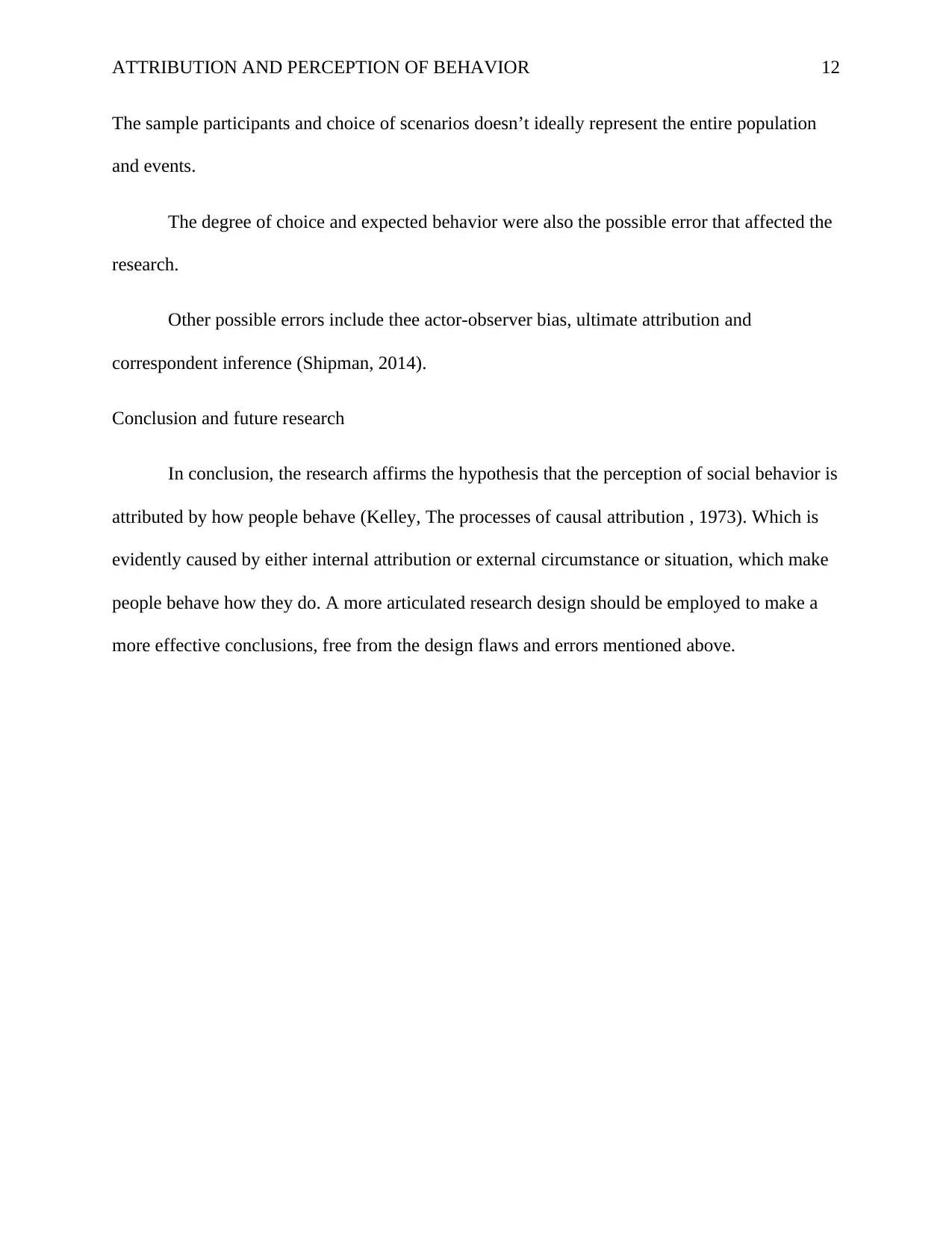
ATTRIBUTION AND PERCEPTION OF BEHAVIOR 12
The sample participants and choice of scenarios doesn’t ideally represent the entire population
and events.
The degree of choice and expected behavior were also the possible error that affected the
research.
Other possible errors include thee actor-observer bias, ultimate attribution and
correspondent inference (Shipman, 2014).
Conclusion and future research
In conclusion, the research affirms the hypothesis that the perception of social behavior is
attributed by how people behave (Kelley, The processes of causal attribution , 1973). Which is
evidently caused by either internal attribution or external circumstance or situation, which make
people behave how they do. A more articulated research design should be employed to make a
more effective conclusions, free from the design flaws and errors mentioned above.
The sample participants and choice of scenarios doesn’t ideally represent the entire population
and events.
The degree of choice and expected behavior were also the possible error that affected the
research.
Other possible errors include thee actor-observer bias, ultimate attribution and
correspondent inference (Shipman, 2014).
Conclusion and future research
In conclusion, the research affirms the hypothesis that the perception of social behavior is
attributed by how people behave (Kelley, The processes of causal attribution , 1973). Which is
evidently caused by either internal attribution or external circumstance or situation, which make
people behave how they do. A more articulated research design should be employed to make a
more effective conclusions, free from the design flaws and errors mentioned above.
⊘ This is a preview!⊘
Do you want full access?
Subscribe today to unlock all pages.

Trusted by 1+ million students worldwide
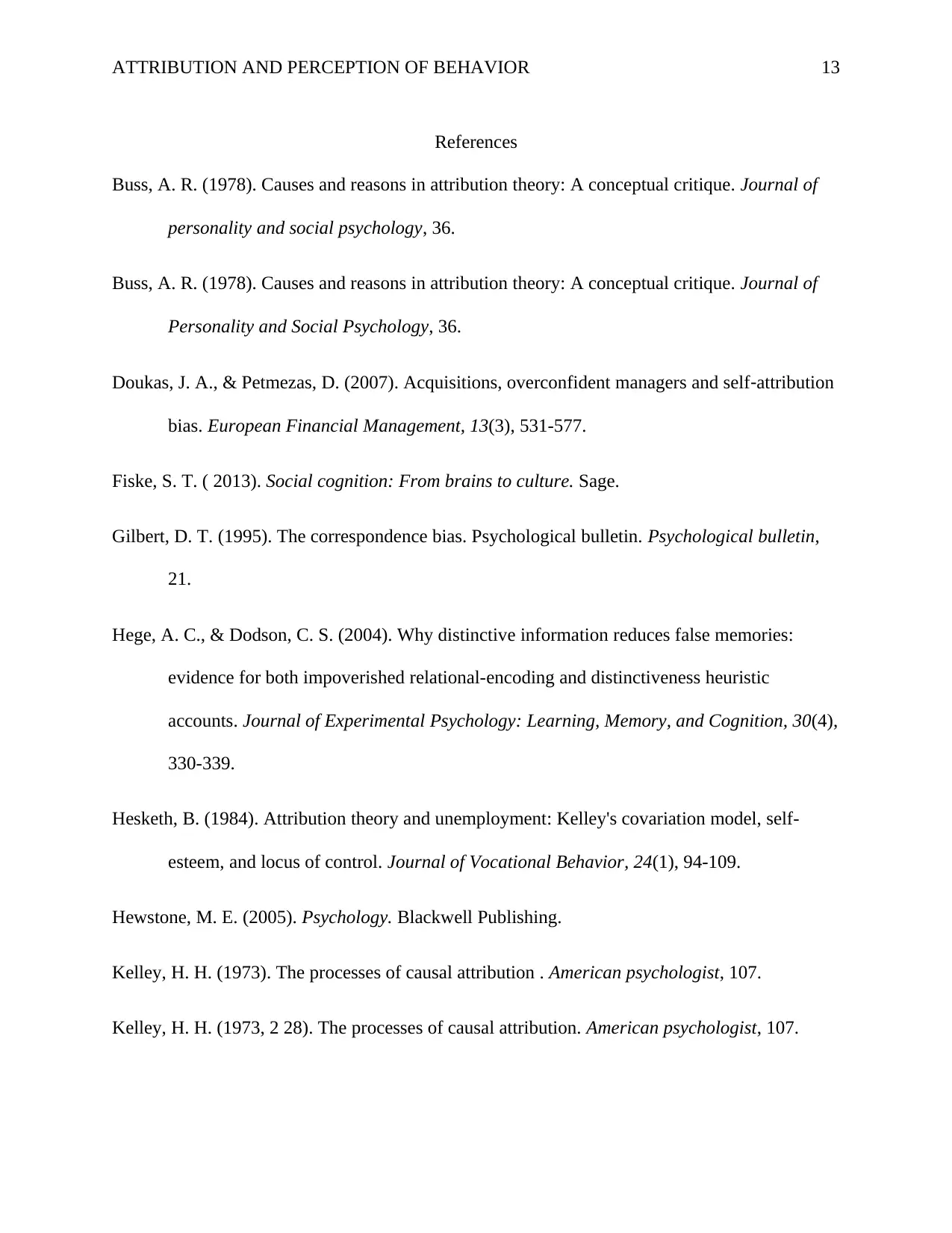
ATTRIBUTION AND PERCEPTION OF BEHAVIOR 13
References
Buss, A. R. (1978). Causes and reasons in attribution theory: A conceptual critique. Journal of
personality and social psychology, 36.
Buss, A. R. (1978). Causes and reasons in attribution theory: A conceptual critique. Journal of
Personality and Social Psychology, 36.
Doukas, J. A., & Petmezas, D. (2007). Acquisitions, overconfident managers and self‐attribution
bias. European Financial Management, 13(3), 531-577.
Fiske, S. T. ( 2013). Social cognition: From brains to culture. Sage.
Gilbert, D. T. (1995). The correspondence bias. Psychological bulletin. Psychological bulletin,
21.
Hege, A. C., & Dodson, C. S. (2004). Why distinctive information reduces false memories:
evidence for both impoverished relational-encoding and distinctiveness heuristic
accounts. Journal of Experimental Psychology: Learning, Memory, and Cognition, 30(4),
330-339.
Hesketh, B. (1984). Attribution theory and unemployment: Kelley's covariation model, self-
esteem, and locus of control. Journal of Vocational Behavior, 24(1), 94-109.
Hewstone, M. E. (2005). Psychology. Blackwell Publishing.
Kelley, H. H. (1973). The processes of causal attribution . American psychologist, 107.
Kelley, H. H. (1973, 2 28). The processes of causal attribution. American psychologist, 107.
References
Buss, A. R. (1978). Causes and reasons in attribution theory: A conceptual critique. Journal of
personality and social psychology, 36.
Buss, A. R. (1978). Causes and reasons in attribution theory: A conceptual critique. Journal of
Personality and Social Psychology, 36.
Doukas, J. A., & Petmezas, D. (2007). Acquisitions, overconfident managers and self‐attribution
bias. European Financial Management, 13(3), 531-577.
Fiske, S. T. ( 2013). Social cognition: From brains to culture. Sage.
Gilbert, D. T. (1995). The correspondence bias. Psychological bulletin. Psychological bulletin,
21.
Hege, A. C., & Dodson, C. S. (2004). Why distinctive information reduces false memories:
evidence for both impoverished relational-encoding and distinctiveness heuristic
accounts. Journal of Experimental Psychology: Learning, Memory, and Cognition, 30(4),
330-339.
Hesketh, B. (1984). Attribution theory and unemployment: Kelley's covariation model, self-
esteem, and locus of control. Journal of Vocational Behavior, 24(1), 94-109.
Hewstone, M. E. (2005). Psychology. Blackwell Publishing.
Kelley, H. H. (1973). The processes of causal attribution . American psychologist, 107.
Kelley, H. H. (1973, 2 28). The processes of causal attribution. American psychologist, 107.
Paraphrase This Document
Need a fresh take? Get an instant paraphrase of this document with our AI Paraphraser
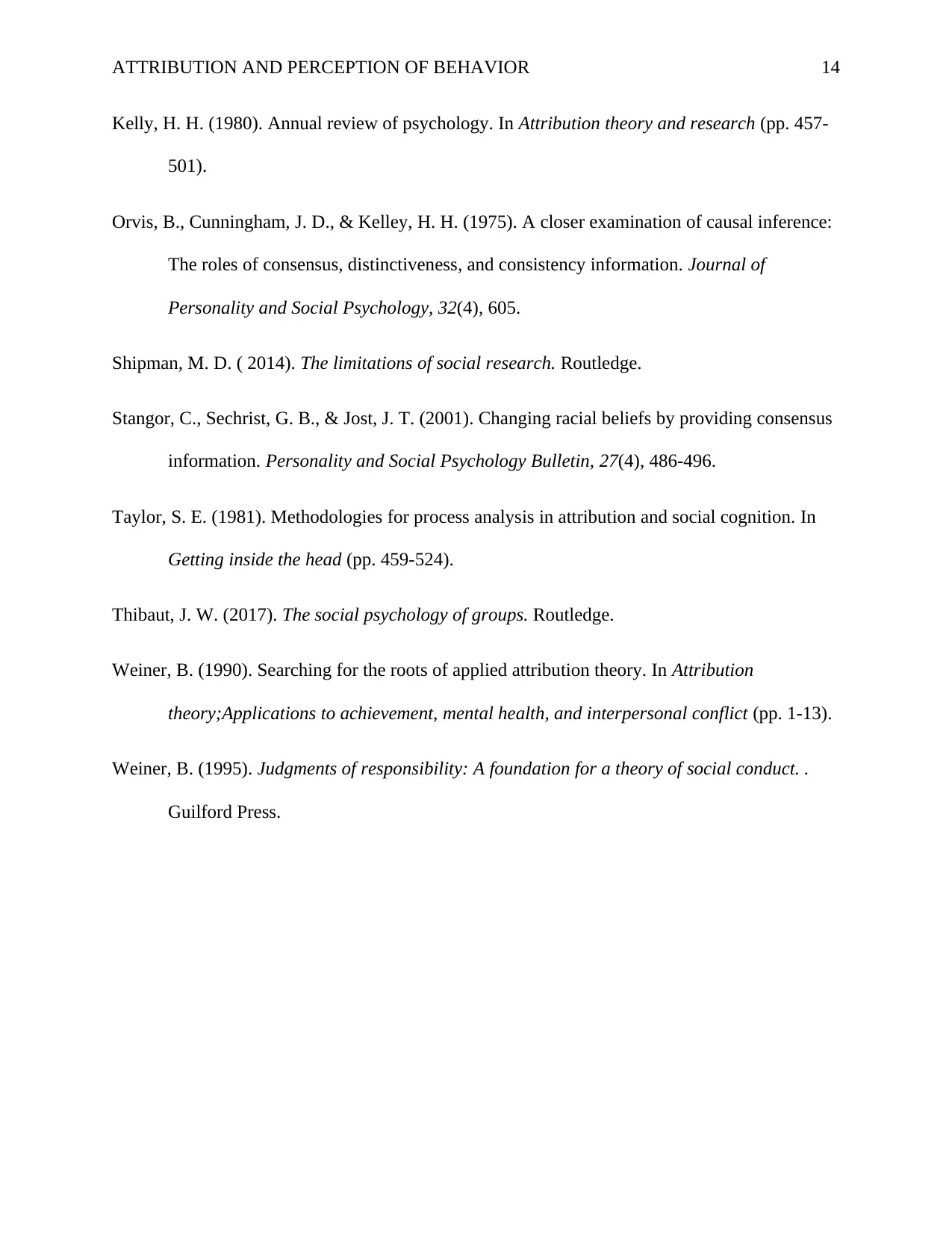
ATTRIBUTION AND PERCEPTION OF BEHAVIOR 14
Kelly, H. H. (1980). Annual review of psychology. In Attribution theory and research (pp. 457-
501).
Orvis, B., Cunningham, J. D., & Kelley, H. H. (1975). A closer examination of causal inference:
The roles of consensus, distinctiveness, and consistency information. Journal of
Personality and Social Psychology, 32(4), 605.
Shipman, M. D. ( 2014). The limitations of social research. Routledge.
Stangor, C., Sechrist, G. B., & Jost, J. T. (2001). Changing racial beliefs by providing consensus
information. Personality and Social Psychology Bulletin, 27(4), 486-496.
Taylor, S. E. (1981). Methodologies for process analysis in attribution and social cognition. In
Getting inside the head (pp. 459-524).
Thibaut, J. W. (2017). The social psychology of groups. Routledge.
Weiner, B. (1990). Searching for the roots of applied attribution theory. In Attribution
theory;Applications to achievement, mental health, and interpersonal conflict (pp. 1-13).
Weiner, B. (1995). Judgments of responsibility: A foundation for a theory of social conduct. .
Guilford Press.
Kelly, H. H. (1980). Annual review of psychology. In Attribution theory and research (pp. 457-
501).
Orvis, B., Cunningham, J. D., & Kelley, H. H. (1975). A closer examination of causal inference:
The roles of consensus, distinctiveness, and consistency information. Journal of
Personality and Social Psychology, 32(4), 605.
Shipman, M. D. ( 2014). The limitations of social research. Routledge.
Stangor, C., Sechrist, G. B., & Jost, J. T. (2001). Changing racial beliefs by providing consensus
information. Personality and Social Psychology Bulletin, 27(4), 486-496.
Taylor, S. E. (1981). Methodologies for process analysis in attribution and social cognition. In
Getting inside the head (pp. 459-524).
Thibaut, J. W. (2017). The social psychology of groups. Routledge.
Weiner, B. (1990). Searching for the roots of applied attribution theory. In Attribution
theory;Applications to achievement, mental health, and interpersonal conflict (pp. 1-13).
Weiner, B. (1995). Judgments of responsibility: A foundation for a theory of social conduct. .
Guilford Press.
1 out of 14
Related Documents
Your All-in-One AI-Powered Toolkit for Academic Success.
+13062052269
info@desklib.com
Available 24*7 on WhatsApp / Email
![[object Object]](/_next/static/media/star-bottom.7253800d.svg)
Unlock your academic potential
© 2024 | Zucol Services PVT LTD | All rights reserved.





